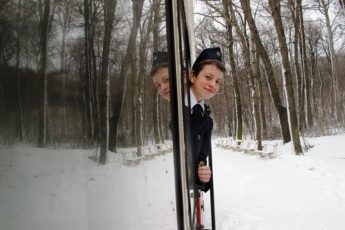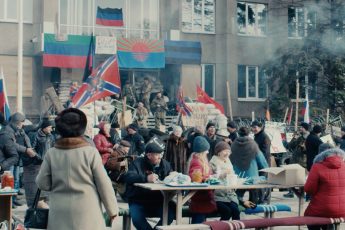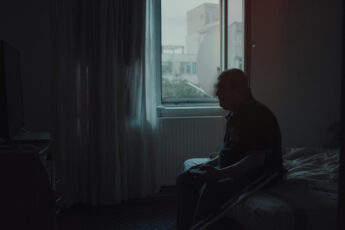The Last Night in White Satin
Jan P. Matuszyński’s The Last Family (Ostatnia Rodzina, 2017)
Vol. 81 (January 2018) by Anastasia Eleftheriou
Renewed interest in the life of Polish artist Zdzisław Beksiński has brought rise to two new films on the painter. Jan P. Matuszynski’s fiction-feature debut, The Last Family, saw its premiere at the Locarno festival in the summer of 2017. A couple of months later an archival documentary by Marcin Borchardt, based on Magdalena Grzebałkowska’s best-selling biography The Beksińskis from 2014, premiered at the Krakow Film Festival.
At a time when biopics are overwhelming the world’s film and art industry, feeding into the need of the masses for national heroes, Matuszynski’s portrait on one of Poland’s most prominent painters uses a refreshingly different approach. Zdzisław Beksiński is not the hero in this biopic. Rather he is depicted as a tragic figure who turns into an allegory for Poland’s violent westernization from the late 1980s to the early 2000s.
The film starts like a domestic drama. A talented and successful painter and a sensitive, yet self-obsessed father, Beksiński (Andrzej Seweryn, who won the best actor award in Locarno) lives with his tender and supportive wife (Zofia Beksinska) and both of their mothers. As in Borchardt’s documentary, Matuszynski’s main concern is Beksiński’s suicidal son, Tomasz (another outstanding performance by Dawid Ogrodnik). Tomasz’s attempts to kill himself parallel his father’s apocalyptic paintings. Yet another narrative strain is provided by social time. While no political or social events are explicitly mentioned, references to the particular period of each scene are established through everyday objects. Thus we witness how technology and consumer products like video cameras and Coca Cola subtly invade the Beksińskis’ private and creative life.
Almost all of the film’s scenes take place in a huis-clos, either in Tomasz’s or his parent’s high-rise flat, which are located in the same block. The narrow space and feeling of entrapment is a recurrent element of the film. It seems like Zdzisław has made a conscious choice of keeping society out of his life, finding a refuge in the dystopian visions of his paintings. As time passes, he lets cameras, recorders and eventually computers become as crucial for his existence as his paintings are. He records the life and death of his family with a small VHS camera, creating an archive of his own life but also of the times he lived in. In that sense it is unclear why some critics faulted the film for keeping the important social context out of the narrative.1
Sure, Tomasz has to deal with existential problems, loneliness, his emotionally unavailable father, the narcissism of an unrestricted upbringing – all tropes of individual psychology and the material for the hermetically self-enclosed narratives of uncountable family dramas. But there’s also Tomasz’s fate in Western culture. Tomasz is a successful music producer and DJ of popular western music. He speaks perfect English and was one of Poland’s most famous voice-over artists, having dubbed James Bond and Monty Python. His personal conflicts can thus also be understood within the social and political contexts of Poland’s transitional period. It is no coincidence that he blames his failed romantic relationships on “the movies” and on this “perfect” world that would not keep its promises. When his mother dies, Tomasz finds comfort in the melody of The Nights in White Satin…
The family drama at the center of this film is thus as much of a social tragedy as it is individual. Both father and son struggle with internal loneliness. But they also have to scramble through the violent transformation of their environment, especially concerning the destructive lure of the false promises of liberty. Nothing represents this better than the title of the film and the particular circumstances in which each family member dies. Tomasz’s suicide right before the new millennium takes on a different meaning considering, for example, the proliferation of films about suicide, depression and social decline that were flourishing in the late 1990s.2 The tragic, unjustified death of Beksiński at the hands of a young working class boy drinking Pepsi cola, also has an almost cynical aftertaste.
And yet, instead of opting for grand gestures and overly conspicuous allegories which were the preferred stylistic devices of films from the 1990s, Matuszynski’s style is far more delicate. One is reminded of Virginia Woolf’s masterpiece The Years, where we observe the small private details of the genteel Pargiter family as “the years pass one after another across the sky” while England experiences one of its most essential historical and social transformations. In The Last Family, the Woolfian hero is the Beksiński family. The subtly present background is Poland, and with it, every other ex-Soviet country under conditions of profound cultural and political change.
Some viewers may think that Matuszynski is riding on the wave of family dramas that have flooded Poland’s cinematographic landscape. However, in focusing on the exceptional life of the Beksiński family, the director stands apart from the claims to the ordinary of most of these domestic deconstructivists. Unlike the paintings of its protagonist and real-life inspiration, which belong to the style of fantastic realism, the film itself could be categorized as a piece of realism – sporadic bizarreness is always integrated into a very realistic context. The beauty of The Last Family lies in its playful form. Though far from being a formalistic experiment, it manages to include re-enacted images of real-life videos Beksiński had shot creating a risky play of mise en abyme.
The first and last scenes of the film show old Beksiński talking about computers, his ethics, and virtual reality. He says he might not live to see virtual reality being part of people’s life. We understand that had he managed to live longer, he would probably be creating his apocalyptic visions in 3D, consciously avoiding paying any attention to Poland’s new law forbidding individuals to assert Poland’s responsibility for the atrocities of World War II. Does this make him ignorant of the autocracy of the event? We can imagine him cynically placing a fancy Coke Zero can right next to his Mac Pro, can’t we? And who would dare to blame him?




Leave a Comment